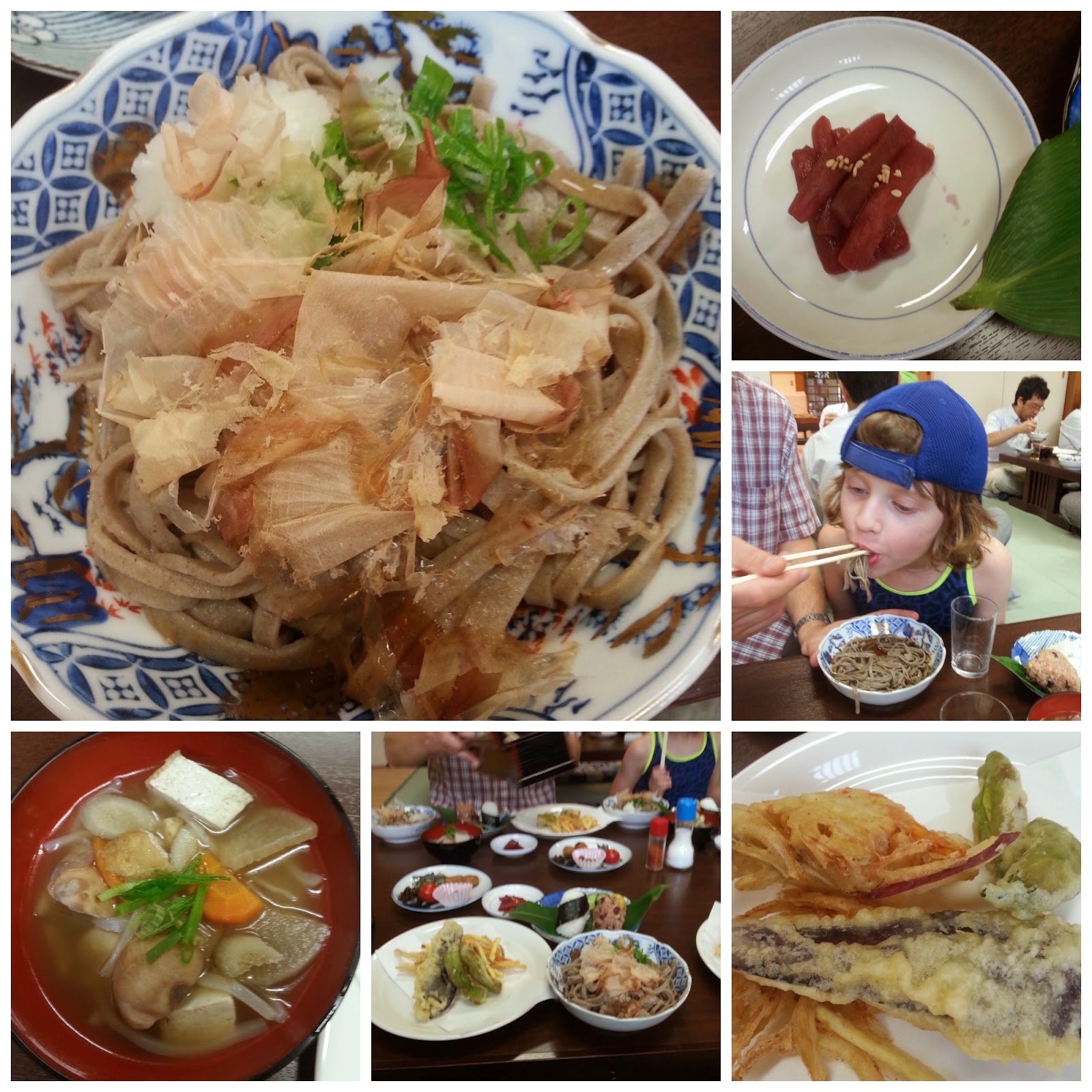Soba Making at Starland Sakadani / スターランドさかだにのそば打ち体験
The Echizen region
of Fukui Prefecture is famous for its soba.
Most people think of rice as being the staple grain of the Japanese
diet, but buckwheat is actually the traditional staple in many parts of Japan. This is particularly true of regions that were not conducive to the growing of rice such as those at higher elevations and in the colder climate of the north. The popularity of buckwheat is demonstrated in the fact that the Japanese word for
buckwheat, soba, is also the common
word for traditional Japanese noodles.
As part of the
Satoyama Forum in Fukui Prefecture last summer, we visited Starland Sakadani to participate in a
soba-making workshop. Soba noodles
consist only of buckwheat mixed with wheat flour and water. The art is in how the dough is kneaded,
rolled, folded, and sliced.
As we made
the soba, behind the scenes women were cooking traditional local food to
serve with the noodles. The meal was completely vegetarian because
this is a mountainous area. Traditionally they would have they would not have had much in the way of livestock and in the
days before modern transport, the location was too far from the sea for fresh
fish and seafood. Outside of Buddhist
temples, it is rare to be served a vegan meal in Japan, let alone a feast such
as the one we enjoyed at Starland Sakadani.
If you would
like to try making soba yourself, check out Starland Sakadani’s step-by-step instructions with
photos (translation below) or book yourself a workshop using the contact
details at the bottom of this post.
Handmade Soba in 15 Steps
Step 1 / 手順.1
Sift the flour. 粉をふるいにかける
Sift
buckwheat (soba) flour and wheat flour into a large bowl.
そば粉、つなぎ粉の木目を整えるためふるいにかけます。
Step 2 /手順.2
Mix the flour. 粉をよく混ぜる
Using your
fingertips, mix the buckwheat flour and wheat flour together.
そば粉と小麦粉をよく混ぜます。混ぜが悪いと水回しがうまくできません。
Step 3 / 手順.3
Add water 1. 水回しその1
Pour water
directly onto the flour a small bit at a time. . .
木鉢最大のポイント。水を数回に分けいれながら…
Step 4 / 手順.4
Add water 2. 水回しその2
Using your
fingertips, mix the flour and water until the flour resembles large
crumbs.
均一に水をなじませないと後の作業が全てうまくいきません。
Step 5 / 手順.5
Fold the dough. くくり
Gently turn
and press the dough to start shaping it into a ball.
耳たぶぐらいの硬さになったら1つにまとめていきます。
Step 6 / 手順.6
Knead the dough 1. 練りその1
Knead the
dough pushing the weight of your body firmly into it until it becomes a smooth
consistency.
「つや」がでて、なめらかになるまで体重を乗せてねります。
Step 7 / 手順.7
Knead the dough 2. 練りその2
Press and
rotate the dough into the shape of a large dumpling.
「つや」がでて、なめらかになったら中の空気を搾り出しながら大きな団子に仕上ます。
Step 8 /手順.8
Press the dough. 地のし
Slowly press
the dough into a fat round of approximately 20 cm in diameter.
(打ち粉を生地の下に多めに振って) めん棒又は手のひらで押して直径20cmくらいまで生地を伸ばします。(以後、打ち粉は少なめに)
Step 9 / 手順.9
Roll out the dough. 丸出し
Begin
flattening the dough with a rolling pin until the dough has increased in
diameter to about 60cm.
「めこの手」でめん棒をすべらせながら直径60cmくらいまで生地を伸ばします。
Step 10 / 手順.10
Form into a
square 1. 角出しその1
With a long
slender rolling pin, roll the dough into the shape of a square.
めん棒に撒き取り、ころがしを繰り返して正方形にし、
Step 11 / 手順.11
Form into a square 2. 角出しその2
Continue
rolling the square until it reaches the size of 90cm per side.
さらに四隅のばして、90cm四の正方形をつくります。
Step 12 / 手順.12
Fold into rectangle. たたみ
Fold the
square of dough into a rectangular shape of many layers. Sprinkle flour generously between each layer
to prevent them sticking. The width of the rectangle should be no more
than the length of your knife.
たっぷりと打ち粉を振りそば切り包丁の幅に畳みます。
Step 13 / 手順.13
Cut.
切り
Using a
wooden board to mark the size and a large knife, slice the dough into noodles
of approximately 2mm thick.
同じ太さに切ることが大切です。太さの目安は2.2ミリです。
Step 14 / 手順.14
Boil.
茹で
Bring water
to a full boil, and boil the noodles for no more than 2 minutes.
そばが泳ぐ位のたっぷりのお湯で。茹で時間は、約 2分以内に。
Step 15 / 手順.15
Serve.
盛り付け
Rinse the
noodles and serve them in a dashi broth with grated daikon, bonito flakes, spring
onions and other toppings according to your preference.
出汁を入れ、たっぷりの大根おろしと好みの花かつお、ねぎ等の薬味を添えお召し上がれ。
Contact information:
Starland Sakadani
大野市役所 スターランドさかだに
1-4
Minomichi, Ōno-shi, Fukui-ken
Tel. +81 779-67-7250
Open: 9am to
4pm
2015
Catherine Munroe Hotes
































